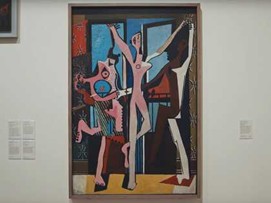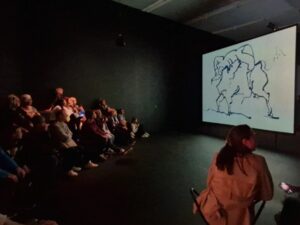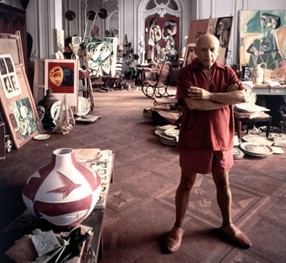Theatre Picasso
Tate Modern, 17 September 2025- 12 April 2026

Pablo Picasso, The Three Dancers, 1925
When I’m not painting, I lose the sense of myself. Painting is the way I organise my thoughts and the way I structure my time, and it’s been this way for over 50 years. I am lucky to have a passion for what I do, but evidently, I’ve been doing too much of it, for too long, and too energetically for these old bones. Injuries have kept me out of the studio for over a month now. The specialist tells me that I suffer from baseball players’ shoulders. If only I could play baseball.
Over the last month I’ve been wandering disconsolately into the sad quiet Marie Celeste of a studio, sniffing at the unfinished paintings on the easels and moving off in a very bad mood. I haven’t even been out and about the city except to see medics. I have also been afflicted with brain fog. It’s the painkillers. I’ve lost a bag of cocktail nuts only to find them days later in the sewing box. I have put lightbulbs in the fridge. I have had my bag with keys and phone in it pinched through lack of concentration. I have not been able to read or go out. It’s dire.
However, as of this week, I am doing much better and am off the pills and am returning to the world, and I went to the latest show at Tate Modern. It was revelatory. Not only did it get me fired up thinking about painting again, but my old up-and-down and in-and-out love affair with Picasso has rekindled big time. I wasn’t actually going to see this show at all, mistakenly thinking I had seen enough Picasso to last me a lifetime, but I am reassured that my admiration of the old goat is stronger than ever. He still has a lot to say and to teach. His protean energy is contagious. He defies you to be complacent about art. He has no boundaries. Art is the flamenco. Art is the bullfight. Art is sex. Art is food. Art is politics. Art is history. Art is myth. Art is the land. Art is the air we breathe. Art is Death.
Art is theatre.

Installation at the Tate Modern
Last summer, on a Cézanne pilgrimage, I went to his hometown of Aix en Provence to see the show of his work at the Musée Granet, and also to visit the Jas de Bouffan, his family home. Cézanne is one of my pole stars. He was also a beacon of light for Picasso. Picasso is buried at the Chateau de Vauvenargues in the hills behind Cézanne’s iconic subject – the craggy peaks of the Mont Sainte Victoire. He is buried in a private family plot in the garden of the chateau, and the gates were firmly locked when I visited, but undaunted I sat in the Provençal sun in the village and gazed at Vauvenargues. I thought about the two men, lodestones of twentieth century painting and how fitting it is that they should lie in the dusty Provençal garrigue so near to one another.
What a conversation they must be having in the afterlife….
Picasso is important for my generation of painters, maybe even the most important artist, for love him or hate him – and I have done both – I think for me the greatest legacy he leaves is that metamorphosis as an artist, changing styles, is a “consummation devoutly to be wished” to quote that old existentialist Prince Hamlet of Denmark. Always a supreme draughtsman, he morphs from being a sentimentalist – the Blue period – to an experimentalist – the Analytical and Synthetic Cubist periods – to his swoony neo-Classical period. He comes out the other side just Picasso plain and far from simple. For me, whose work has shifted in style over the long years, he is as much a touchstone as Cézanne was for him. The history of art is a circus act, an acrobatic feat. As Isaac Newton famously said ; “if I see further, it is because I am standing on the shoulders of giants”. Picasso is a giant. All of us painters are standing on his sturdy, muscled shoulders.

Pablo Picasso in Cannes, France in 1956
This show includes lithographs, etchings and iconic paintings. Among other treasures, there is a wildly camp film of Picasso acting Carmen in a mantilla, but the real highlight of this show is the dark theatre that has been created in the middle of the show. Picasso paints 20 paintings in stop motion film in real time on a huge lighted screen on the other side of the easel and it’s just delightful. This film, called Le Mystère Picasso was made by Henri-Georges Clouzot in 1956, and won the special jury prize at Cannes that year. I’ve never seen it before, and the children in the audience were as entranced as I. He appears to rest his brush with an amazing image for a minute or two, but no, he paints over it. The facility of his line drawing turns a mere squiggle into the flaring nostrils of a horse, or the muscled legs of an acrobat, a dead toreador, the generous thighs and breasts of a nude, a goat, or a bull worthy of Goya. One prays “oh please Picasso don’t destroy it, it’s so brilliant” but he moves on. It turns into another beast altogether. At one point he comes out, a wicked grin on his face, from behind the screen. He looks like a French matelot and a Catalonian Wizard of Oz. Clouzot congratulates Picasso, who summarily rejects his compliments, saying “No, I must take more risks” and he goes back behind the screen to paint over what he has done.
“Painting is the sum of destructions.” Pablo Picasso